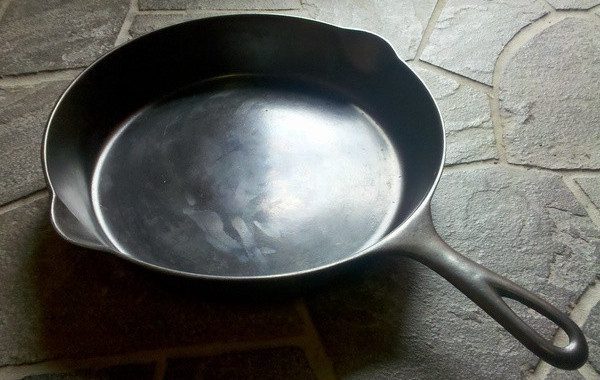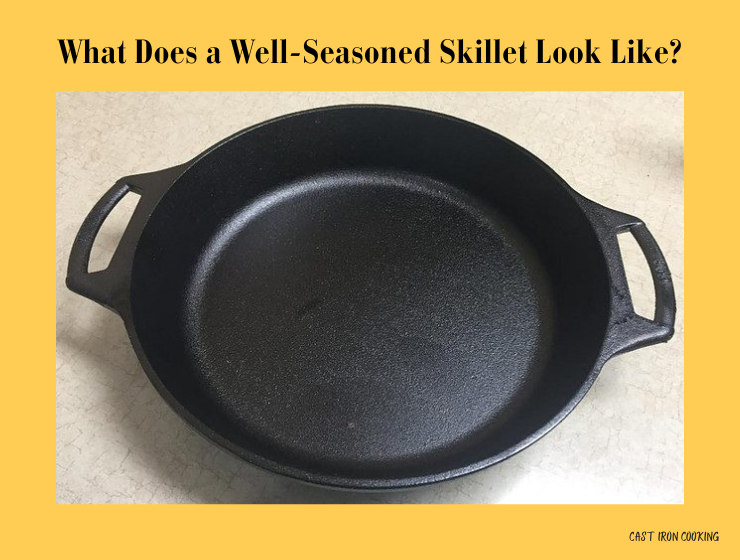So, what does a well-seasoned skillet look like?
You read and hear about having a well-seasoned skillet, but they often just say the words and don’t explain what they mean.
I used to think it meant a glossy finish.
And that it took years and years to have a well-seasoned skillet because that’s how long it took to build enough layers to make it smooth.
However, the more I researched, the more I realized it couldn’t mean that.
Because too many people talked about using a well-seasoned skillet, and when you saw their pan, it wasn’t glossy, but it was nonstick.
So what does it mean to have a well-seasoned skillet?
Does it have to be smooth? Shiny? Nonstick?
Let’s find out.
Table of Contents
What Does a Well-Seasoned Skillet Look LIke?
A well-seasoned skillet is a pan that doesn’t need to be reseasoned because it is already working the way it’s supposed to work. The pan will be free of rust and flaking. And it won’t be sticky or have food that is stuck to it. These things all make cooking more difficult. Instead, your skillet will be relatively nonstick and only need regular maintenance.
What I Thought a Well-Seasoned Skillet Was

This is a picture of the ideal well-seasoned skillet.
At least in my mind.
I think it’s what a lot of people picture when you ask them what well-seasoned means.
When I saw my friend’s skillet that looked just like the one in the picture, I thought it was beautiful.
It was black, shiny, and smooth.
Mine didn’t look anything like that. But it cooked well.
Thus, it begs the question: Can you have a well-seasoned skillet if it doesn’t look black, shiny, and smooth?
I say you can.
A well-seasoned skillet will have or be free from the following five qualities:
1. Your Skillet Will Be Black
Since seasoning is black, it only makes sense that this will be the color of a well-seasoned skillet.
However, most skillets will look black, even the ones that aren’t well-seasoned.
So it’s not enough to just have a black skillet.
RELATED > > > > > Why is Cast Iron Cookware Black?
2. Your Skillet Won’t Be Sticky
| TYPE OF OIL | Smoke Point | Flavor Neutral |
| Avacado (Virgin) | 520°F/271°C | NO |
| Safflower | 500°F/260°C | YES |
| Light/Refined Olive | 465°F/240°C | YES |
| Rice Bran | 450°F/232°C | YES |
| Soy Bean | 450°F/232°C | YES |
| Peanut | 450°F/232°C | YES |
| Corn | 450F/232°C° | YES |
| Sesame | 450°F/232°C | NO |
| Sunflower | 440°F/226°C | YES |
| Canola | 425°F/218°C | YES |
| Grapeseed | 420°F/215°C | YES |
| Vegetable | 400°F/204°C | YES |
| Extra-Virgin Olive | 375°F/190°C | NO |
| Vegetable Shortening | 360°F/182°C | YES |
| Coconut | 350°F/176°C | NO |
| Flaxseed | 225°F/107°C | NO |
If your skillet is black but sticky, it’s not well-seasoned.
Many people wonder why their cast iron pan is sticky to the touch.
And as surprising as it may sound, stickiness usually is because you are putting too much oil on your skillet when you season it in the oven.
Or you’re not baking the pan long enough or at a hot enough temperature.
When seasoning your skillet, you want to heat the pan to the oil’s smoke point or higher.
However, if using Avocado oil (smoke point 520°F), do not exceed 500°F. Anything over that temperature will start burning off the seasoning.
And you’ll want to bake it long enough for the oil to polymerize, usually an hour.
There are hundreds of seasoning methods, all claiming their way is the best way.
I have no doubt that many methods work. I’m not sure there is a best way, though.
Regardless of the method, if the oil doesn’t polymerize (bake into the pan all the way), it will be sticky.
All methods call for you to coat the entire pan with a thin layer of oil.
But the word “thin” is subjective, and you may not even realize you put too much on. In other words, the layer of oil looks thin to you.
How To Make Sure The Layer is Thin
Your method may not explain that after you’ve added the thin layer of oil, you should wipe it off so it looks like the oil is gone.
But it’s not gone; it’s still there. It’s just thin.
I use a cloth, but a paper towel works too.
To fix stickiness, simply put your pan in the oven upside down at 450-500°F for an hour. If it’s still sticky after it’s cooled, repeat.
Once the oil has completely baked into the pan, it will no longer be sticky.
And your skillet will be sell-seasoned.
3. Your Skillet Won’t Have Rust
Another quality of a well-seasoned skillet is it won’t have any rust.
According to Lodge, surface rust isn’t harmful to your pan, but it will need to be restored.
Restoring your skillet is basically reseasoning it with the added step of removing the rust.
Follow these steps:
- Scour with warm, soapy water and a scouring pad. Metal, such as chainmail or steel wool, works well for removing rust.
- Add a thin layer of oil to the entire pan using a paper towel. Remember to use a clean paper towel or cloth to wipe the oil off to ensure the coating is thin and, thereby, avoid stickiness.
- Place the skillet upside down in a 450-500°F oven for an hour. Let the skillet cool inside or remove it and repeat the process if necessary.
4. Your Skillet Won’t Have Flaking
Flaking is another problem that isn’t harmful in any way but is the breakdown of the seasoning.
When your skillet is new, you might see some, but the more you cook with it and the more layers of seasoning you build up, the less you will have.
If you’ve been using your skillet for a while and have problems with flaking, you will want to reseason it.
Follow the seasoning steps for rust (directly above), except you will lightly scour to remove the flakes, not the rust.
5. Your Skillet Won’t Have Any Stuck-on Food
This one may seem obvious. But at times, you will have stuck-on food that will change the status of your skillet until it is removed.
If you’ve been cooking for a while in your pan that has stuck-on food, you may have to scrub it quite a bit more to get the food off.
However, if it’s in a pan you recently finished using, just use a scraper to get as much food off as possible.
After that, heat the pan, and while it’s hot, run it under hot water to loosen and make the rest easier to clean.
But, if that doesn’t work, simmer an inch of water in the skillet for several minutes before cleaning.
If the food is particularly stubborn, you may have to reseason (see steps in #3, Your skillet won’t have rust).
6. Your Skillet Will Be Relatively Nonstick
Your skillet doesn’t have to be as nonstick as Teflon to be considered well-seasoned, but you shouldn’t have problems with your food sticking.
Cast iron needs a little oil.
If you find yourself too often scraping off stuck-on food that shouldn’t have stuck, it might be that you’re not using enough oil.
Or it may be time to reseason.
The go-to test is the egg test. If you can cook an egg (with fat) without it sticking, your pan is well-seasoned.
Eggs on a New Cast Iron?
Final Thoughts
What does a well-seasoned cast iron skillet look like?
Hopefully, you now have a better understanding of what to look for.
It has to be black, but not necessarily smooth or shiny. Smooth comes later or with stripping the pan down and making it that way yourself.
However, you won’t want to see any rust or significant flaking.
You don’t want your pan to be sticky or have food stuck on it.
And most importantly, you want your pan to be relatively nonstick.
So, how do you define well-seasoned?
